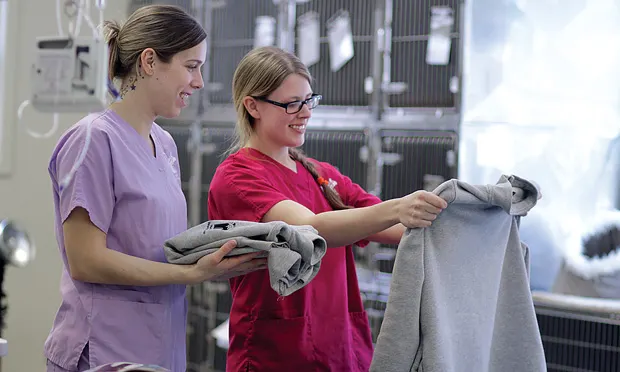Drafting a Practice Dress Code

A veterinary practice should always be aware of its image, inside and out. The condition of the building is an important marketing opportunity; however, inside the practice is an even stronger marketing tool—every team member is a walking billboard that conveys the practice’s image and makes a statement to the clients about the style of the practice.
Is there only one correct style?
Related Article: How to Discuss Professionalism with Your Team
Consider the regional and cultural image of the city or town. A practice in a ritzy or high-end part of town should probably fit that image, outfitting its team members with sharp-looking, matching uniforms and following strict grooming standards. In another part of town populated by young, progressive individuals, tattoos and piercings may be considered hip and acceptable. In a rural practice, a more natural look may be appropriate, allowing the team to wear denim and adhere to less stringent standards.
So, no—one size does not fit all when it comes to practice style. Each practice needs to know what its clientele expects and appreciates and adopt a dress code accordingly. Every practice handbook or policy manual should include a dress code that covers these 3 topics:
Related Article: Practical Tips: Through Your Client's Eyes, Part 1
1. Uniform Appearance
Every team member should be educated about the necessity of displaying a professional appearance that fits with the practice culture, ensures that clients and business colleagues are favorably impressed, and enhances the reputation of the practice. Any dress code the practice adopts should curtail sloppy appearance, promote team professionalism, and enable clients to easily identify team members.
The team’s appearance represents the clients’ expectations.
2. Personal Touches
Team members will often want to accessorize, and any practice dress code should clearly identify what is or is not acceptable in the practice. Then, team members can be asked to cover or remove accessories that may offend the clientele and do not fit the practice image. However, be sure that policies do not infringe on any religious practices (eg, piercings and tattoos may be common in some Eastern religions). Address each member individually about such items and make any necessary accommodations.
3. Scents & Smells
In a veterinary practice, it is impossible to completely avoid unpleasant smells, but they should be minimized as much as possible. The dress code should contain a section about limiting strong smells and aromas, such as body odor and perfumes. Similarly, the practice in general should limit scented candles, incense, and air fresheners. Keep in mind, also, that some team members and clients may be sensitive to certain smells or fragrances. When strong-smelling products (eg, patient grooming sprays, coat fresheners) are necessary, a special area should be set aside for their use.
Leadership should always get input (eg, on the colors of scrubs) from team members when determining the practice dress code, and once the code is in place, should always explain the reason for the practice’s policies and restrictions. Ideally, a dress code should also include a blanket policy to be used at leadership’s discretion:
It is impossible and undesirable to define an absolute code for dress, markings, piercings, and fragrances. Our practice will apply a rule of reason on a case-by-case basis.
Team members may argue for freedom of individual expression in the way they dress, but in the workplace, any dress code or policy is “law.” Outside the practice, they are free to express themselves.
Creating a welcoming environment for clients and patients is critical to the success of the practice. The team’s appearance represents the clients’ expectations. Be sure to document the factors that fulfill these expectations and ensure consistency to maintain the practice style.